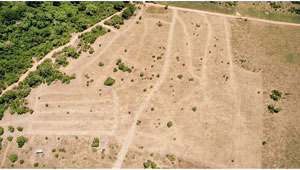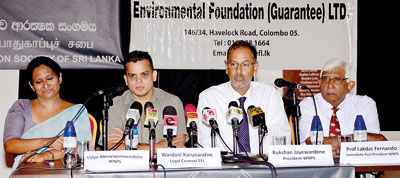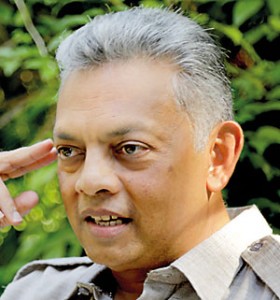News
Spread the word of what is happening at Pallekandal shrine

With the Pallekandal shrine on the left hand corner, the area cleared within the Wilpattu National Park
The feast is over, held amidst a large crowd at the St. Anthony’s shrine at Pallekandal, within the Wilpattu National Park (WNP) in early July, but the burning issues linked to the clearing of a Protected Area (PAs) and expansion of the shrine still linger.
The activities by a section of the Roman Catholic Church within the Wilpattu National Park around the Pallekandal shrine are clear violations of the country’s Fauna and Flora Protection Ordinance (FFPO), under which fall all PAs, was the strong and clear view put forth by two powerful environmental organisations at a media briefing on Tuesday.
Their passionate pleas were supported by a presentation with images which indicated the expansion of the Pallekandal shrine.
While the church acknowledges that the feast is only held once a year implying that crowds gather at the shrine once a year (see box), environmentalists are insistent that crowds gather every first Tuesday of the month, violating the FFPO.
With an urgent appeal by the Wildlife and Nature Protection Society (WNPS) and the Environmental Foundation Ltd. (EFL) to the media to spread the word of what is happening at Pallekandal to the public, the Sunday Times learns that the two groups are looking at their ‘next strategy’ in case wiser counsel does not prevail.
“We are willing to go to court,” said EFL Legal Consultant Wardani Karunaratne, reiterating that whatever you can do or cannot do within a PA is clearly stipulated by the FFPO. “Everyone must abide by the law.”
Referring to the claim that Pallekandal is an old shrine, she was quick to point out that whether it is ‘traditional use, practice or custom’ it should be regulated within the FFPO.

EFL Legal Consultant Wardani Karunaratne, WNPS’s Vidya Abhayagunawardena, WNPS President Rukshan Jayewardene and WNPS Immediate Past President Prof. Lakdas Fernando at the media briefing. Pix by Indika Handuwala
Explaining that the Wilpattu National Park comes under the jurisdiction of the Department of Wildlife Conservation (DWC), the President of WNPS, Rukshan Jayewardene pointed out that even if the shrine has been there for more than 300 years, the use of the shrine comes under the conditions of the FFPO.
While stating that according to information they have gathered more than 30,000 people took part in the July feast at Pallekandal, he underscored that now every week people are visiting the shrine without adhering to the rules which govern visitors to any National Park.
The area being cleared by the church around the shrine within the Wilpattu National Park is the home and feeding grounds of wild elephants, said Mr. Jayewardene, adding that a rare sight at Wilpattu, about 50 elephants together, can be seen in the Pomparippu area where the shrine is located.
“PAs are what we hold in trust for unborn generations,” he said, adding: “They are our heritage.”
The Immediate Past President of WNPS, Prof. Lakdas Fernando, meanwhile was of the view that the Head of the Roman Catholic Church, Pope Francis, would be in favour of the appeal by environmentalists not to destroy the Wilpattu National Park as the latter is an ardent advocate for the preservation of nature and wildlife.
Pointing out that the Pallekandal issue is nothing to do with religion, but everything to do with violations of the law, Vidya Abhayagunawardena of the WNPS echoed the view that if the destruction of the Wilpattu National Park and other PAs continue future generations may not see an elephant in the wild.

A road-clearing machine at the entrance to the shrine.
On July 7, WNPS President Rukshan Jayewardene wrote letters of protest about what is happening at Pallekandal to President Maithripala Sirisena; the Acting Director-General of the DWC, W.S.K. Pathiratna; and the President of the Catholic Bishops’ Conference of Sri Lanka, Malcolm Cardinal Ranjith.
While the Presidential Secretariat replied on August 1 that “your grievance” has been submitted to the Mahaweli Development & Environment Ministry, the Cardinal has stated in reply on July 27 that as per the Ecclesial Law, the matter comes under the purview of the Diocese of Chilaw and as such the letter needs to be addressed to Bishop Valence Mendis.
“Therefore, I suggest that you take this matter up with His Lordship directly and find an acceptable solution to this issue. According to the code of Canon Law this matter is strictly under his jurisdiction,” states the Cardinal.
The Sunday Times published two articles on the Pallekandal issue on the urgings of environmentalists who provided photographic evidence of the harm being done to the Wilpattu National Park. They were ‘Shameful saga at Pallekandal shrine’ on June 19 and ‘Pallekandal shrine going ahead with alleged destructive plans’ on July 3. Numerous attempts to contact the Bishop of Chilaw and the Vicar-General to get their “side” before publication of both these articles proved futile.
| “Clarification” by the Roman Catholic Church The Roman Catholic Church in a ‘clarification’ about the Pallekandal shrine issue published in its official newspaper ‘Messenger’ in July states thus: * Pallekandal shrine is known for its miracles since the 17th century and is one of the most visited places in the country during its annual festival on July 10th. * St. Joseph Vaz (who came to Sri Lanka in 1687 and remained here for 24 years) visited Pallekandal on his way to Puttalam from Mannar and put up a “little chapel” to St. Anthony at Pallekandal with a few persecuted Catholics living in the same village. * The shrine at Pallekandal situated on the old Puttalam-Mannar Road has attracted “thousands of devotees” since then until it was acquired by the government in 1972 for the “buffer zone” of the Wilpattu National Park. * When J.R. Jayewardene became the Executive President, “on instructions given by him”, the late Bishop Edmond Peiris agreed to refrain from claiming compensation for the 143 acres of land owned by the church which included the acquired villages of Pallekandal and Wellamundal, on the expectation of an alternative grant for the shrine. * As a second step, President Jayewardene directed the Land Settlement Department to assure a land grant or a land permit of 6 acres and 3 roods for the church which is on record. * Since then the annual feast has been celebrated with support from the government. Instructions given by President Jayewardene through a letter dated 02.07.1982 of Douglas Liyanage, then Secretary to the President, advised the Director of Wildlife to provide all necessary facilities for the annual church feast….and for such facilities to be provided every year thereon for the feast. * With the conflict in 1983, the shrine became inaccessible until 2009. The old Puttalam-Mannar Road was unsafe for use due to unlawful activity. The annual feast was cancelled. * After the conflict, devotees began visits to the shrine to celebrate the feast – in 2010 it was held with basic facilities and assistance provided by the government. Shrine was restored with some help received from the government. The Priests’ Mission House was restored with a toilet which even today has only a cadjan roof. * The Feast is held under the guidance of the State Authorities — After the land acquisition in 1972 by the government, the existing Shrine is now in the buffer zone of Wilpattu National Park. The Diocese of Chilaw has taken every possible measure to co-operate with the Government officials to organise the feast conveniently so as to avoid even the slightest possibility of disturbances in the buffer zone. * Several discussions are held in preparation for the feast co-ordinated by the Wanathavilluwa Divisional Secretariat. The Department of Wildlife Conservation is often consulted and nothing is worked out without their consent and consultation in organising the feast once a year. The Department of Christian Affairs supplies the movable toilets for the use of the pilgrims.
|
This is totally unacceptable, says former Wildlife DG  Dr. Sunith Pilapitiya “No land within a National Park can come under private ownership,” was the categorical answer of Dr. Sumith Pilapitiya, the former Director-General of the Department of Wildlife Conservation (DWC). The land in any National Park belongs to the DWC and only ‘traditional use’ by others with DWC permission is allowed, he said, explaining that to the “best of my knowledge” the Roman Catholic Church has only such use once a year in July for a few days to celebrate the feast at Pallekandal within the Wilpattu National Park. The Pallekandal feast is held by the Wanathawilluwa Parish which falls within the Diocese of Chilaw, it is learnt. Pointing out that it is in ‘Sanctuaries’ that private people can “own” land but even they have to conform to certain conditions, Dr. Pilapitiya said the DWC has gone to court in connection with violations of the Fauna and Flora Protection Ordinance (FFPO) around the Pallekandal shrine area. A ‘Protected Area’ is an umbrella term which covers ‘Natural Reserves’, ‘Sanctuaries’ and ‘Managed Elephant Reserves’. It is an area of land or sea that is especially dedicated to the protection and maintenance of biodiversity/natural resources and managed through legal or other effective means. A ‘National Park’ falls under the ‘Natural Reserves’ category where the public is allowed to see and study wildlife within certain rules and regulations which ensure maximum protection to wildlife and their habitats. According to Dr. Pilapitiya, this year, the church was informed by the DWC that the existing structures at the site of the shrine cannot be extended or expanded with any permanent buildings. Only temporary buildings could be put up which had to be dismantled as soon as the feast was over. All these years, especially during the conflict times, the shrine was venerated only for five days a year, but now the DWC is perturbed and concerned as there are organized moves to bring in devotees every first Tuesday of the month, he said, stressing that this is “totally unacceptable”. These devotees move around the Wilpattu National Park without following the rules that have to be adhered to by visitors.
|

